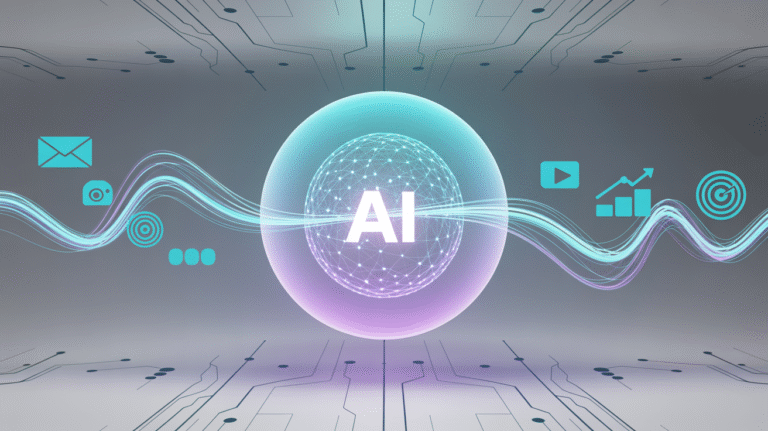How AI is Transforming Market Segmentation
Introduction
In the rapidly evolving landscape of digital marketing, artificial intelligence (AI) is emerging as a game changer, particularly in the field of market segmentation. Market segmentation, the practice of dividing a broad consumer or business market, typically consisting of existing and potential customers, into sub-groups of consumers based on some type of shared characteristics, has been revolutionized by AI technologies. By leveraging machine learning algorithms and predictive analytics, businesses can now achieve a more precise, data-driven approach to segmenting their audience. In this article, we will explore how AI is transforming market segmentation, the benefits it offers, and real-world examples of its application.
The Evolution of Market Segmentation
Before AI, market segmentation was largely based on broad demographic data such as age, gender, income, and location. Marketers relied on traditional methods, often resulting in generalized groups that lacked the specificity needed for tailored marketing campaigns. The rise of big data analytics, however, has introduced a new era in segmentation, moving beyond basic demographics to incorporate psychographics, behavior patterns, and purchasing history.
Today, AI technologies allow businesses to sift through vast amounts of data in real time, uncovering patterns and insights that were once impossible to detect manually. Machine learning algorithms, for instance, can analyze customer behavior, predict future actions, and even personalize offers for specific market segments.
How AI Enhances Market Segmentation
- Data-Driven Segmentation
Traditional market segmentation often involved segmentation based on predefined categories. AI changes this by creating dynamic, data-driven segments. Machine learning algorithms can analyze vast datasets, from customer purchasing history to browsing behaviors, social media interactions, and more, to create precise and adaptive segments. These segments are constantly updated in real-time, reflecting the changing preferences and behaviors of customers.
Example: A retail brand using AI might segment its audience based on a combination of past purchases, browsing habits, and social media activity. This allows for hyper-targeted campaigns that speak directly to the individual’s preferences and behavior.
- Behavioral Segmentation
AI is especially effective in behavioral segmentation. By analyzing how customers interact with a brand across multiple touchpoints—whether it’s their clicks on an e-commerce site, the time they spend watching a particular ad, or their interactions on social media—AI can categorize them based on specific behaviors. These insights enable companies to target users with the most relevant content or offers.
Example: An e-commerce platform could use AI to segment users based on their product interactions. A person who frequently browses athletic wear might be grouped into a segment for fitness enthusiasts, allowing the company to target them with personalized fitness-related offers.
- Predictive Analytics for Market Segmentation
One of the most powerful applications of AI in market segmentation is predictive analytics. AI can analyze historical data and predict future customer behaviors. By understanding trends and patterns, businesses can proactively segment customers who are likely to convert or engage with specific offers. This predictive approach increases conversion rates by targeting the right customers at the right time.
Example: A subscription-based service could use predictive analytics to identify customers at risk of churn and target them with special offers or incentives tailored to their specific behaviors, such as discounts on services they’ve used the most.
- Personalized Marketing Campaigns
AI enables businesses to move beyond generic marketing tactics by creating hyper-personalized campaigns for different market segments. By utilizing AI-driven data insights, companies can tailor their messaging, offers, and even the product recommendations shown to different segments of their audience. This level of personalization leads to higher customer engagement and improved conversion rates.
Example: Netflix uses AI to segment its audience based on viewing habits and then recommends content that fits their preferences. Similarly, an online clothing store can recommend outfits based on a customer’s past browsing behavior.
The Benefits of AI in Market Segmentation
- Increased Accuracy and Precision
AI allows businesses to create more accurate and specific customer segments than traditional methods. With AI, businesses can segment their audience based on more granular characteristics, such as individual buying patterns and specific preferences, resulting in higher precision in targeting and reduced wastage in marketing efforts.
- Cost-Effective Marketing
AI can help businesses achieve more effective segmentation with less manual effort, leading to cost savings. By automating the segmentation process and enabling more targeted marketing, businesses can allocate their marketing budgets more efficiently, reducing costs associated with broad, less effective campaigns.
- Real-Time Adaptability
AI-driven market segmentation is dynamic and adapts in real time. Traditional segmentation models often become obsolete as customer behavior evolves. AI, however, can update segments based on new data instantly, enabling businesses to respond to changing market conditions more quickly and accurately.
- Improved Customer Experience
By offering highly personalized content, recommendations, and marketing messages, AI-driven segmentation enhances the customer experience. Customers feel understood and valued when they receive relevant, tailored communications, which can lead to stronger brand loyalty and customer retention.
Real-World Applications of AI in Market Segmentation
- Spotify: Personalized Playlists and Recommendations
Spotify uses AI-driven market segmentation to provide personalized music recommendations. By analyzing user behavior, listening patterns, and preferences, Spotify creates personalized playlists and suggestions, ensuring that users always have fresh content tailored to their tastes.
- Amazon: Personalized Product Recommendations
Amazon’s recommendation engine uses AI to segment customers based on their browsing and purchasing history. This allows Amazon to provide personalized product recommendations, increasing the likelihood of additional purchases and improving the customer shopping experience.
- Target: Predictive Segmentation for Customer Retention
Target uses AI to predict when customers are likely to make a purchase based on their past buying behaviors. This allows the retailer to send personalized offers to customers at the right time, increasing the chances of conversion and improving customer retention rates.
Challenges and Considerations
While AI-driven market segmentation offers significant benefits, it is not without challenges. One of the primary concerns is data privacy. As businesses gather and analyze large amounts of customer data, they must ensure that they comply with data protection regulations such as GDPR. Additionally, there is the potential for algorithmic bias, where AI systems might inadvertently reinforce existing biases in the data.
Conclusion
AI is revolutionizing market segmentation by offering more precise, dynamic, and personalized approaches to targeting customers. By leveraging machine learning, predictive analytics, and real-time data, businesses can create more effective marketing strategies, improve customer experiences, and drive greater profitability. As AI continues to evolve, its role in marketing segmentation will only become more critical, pushing the boundaries of what is possible in consumer engagement and brand growth.


